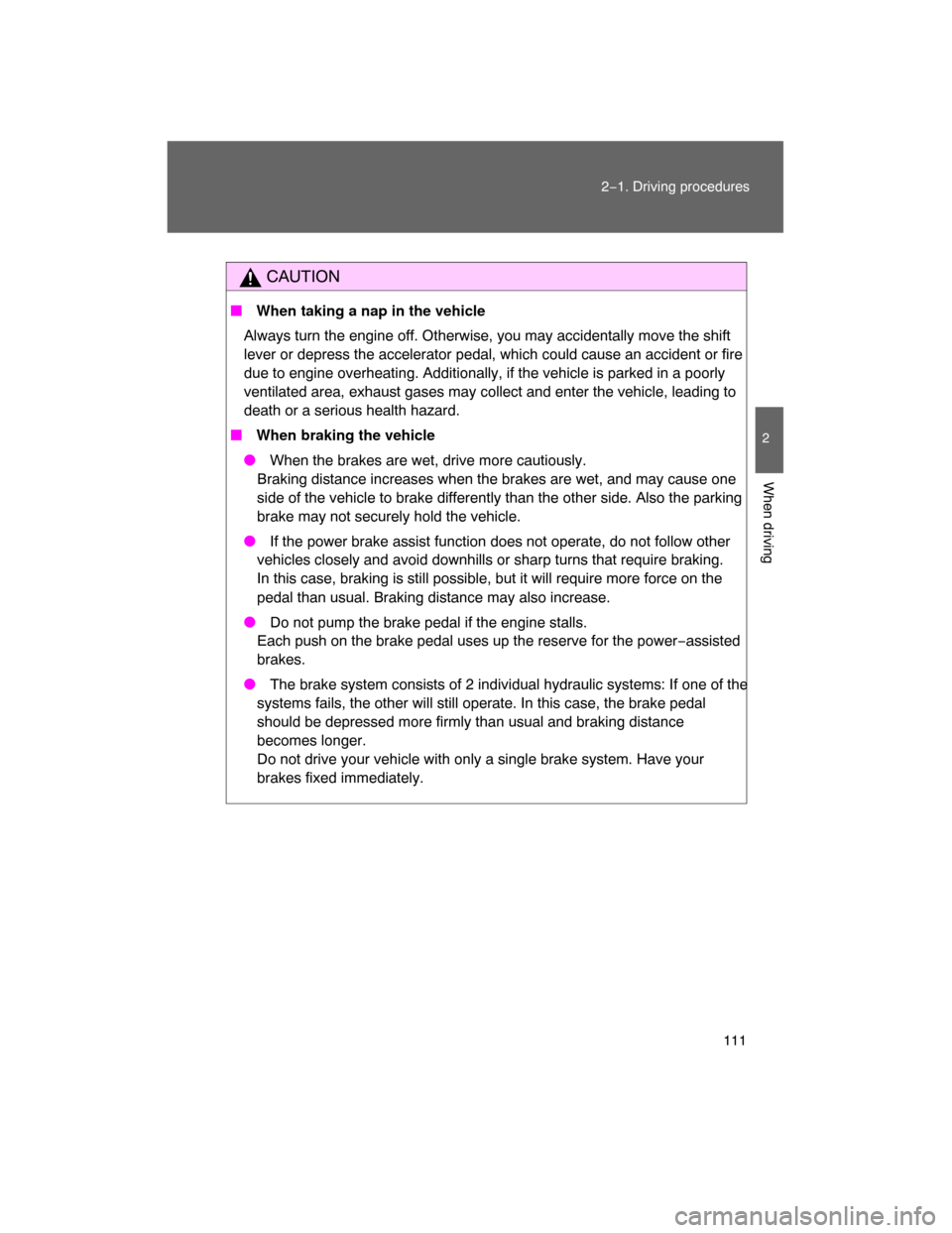Page 4 of 400

TABLE OF CONTENTSIndex
4
Floor mat ............................ 247
Luggage storage box (vehicles
without sub woofer) .......... 248
Luggage compartment
features ............................ 249
Compass ............................ 252
4�1. Maintenance and care ...... 258
Cleaning and protecting the
vehicle exterior ................. 258
Cleaning and protecting the
vehicle interior .................. 260
4�2. Maintenance ..................... 263
Maintenance
requirements .................... 263
General maintenance ......... 265
Emission inspection and
maintenance (I/M)
programs .......................... 268
4�3. Do�it�yourself
maintenance ................... 269
Do−it−yourself service
precautions ...................... 269
Hood ................................... 273
Engine compartment .......... 274
Tires ................................... 287
Tire inflation pressure ......... 292
Wheels ............................... 296
Air conditioning filter ........... 298
Key battery ......................... 301
Checking and replacing
fuses ................................ 303
Light bulbs .......................... 3145�1. Essential information ....... 322
If your vehicle needs to be
towed ................................ 322
If you think something is
wrong ................................ 327
Fuel pump shut off
system .............................. 328
Event data recorder ............ 329
5�2. Steps to take in an
emergency ...................... 331
If a warning light turns on
or a warning buzzer
sounds... ........................... 331
If you have a flat tire ........... 340
If the engine will not start .... 350
If the shift lever cannot be
shifted from P ................... 351
If you lose your keys ........... 352
If the vehicle battery is
discharged ........................ 353
If your vehicle overheats ..... 356
If the vehicle becomes
stuck ................................. 359
6�1. Specifications ................... 362
Maintenance data
(fuel, oil level, etc.) ........... 362
Fuel information .................. 372
Tire information ................... 375
4Maintenance and care
5When trouble arises
6Vehicle specifications
Page 106 of 400

108 2−1. Driving procedures
CAUTION
� When driving the vehicle
� Do not shift the shift lever to N while the vehicle is moving.
Doing so may cause the engine brake to not operate properly and lead to
an accident.
� Do not turn the engine off while driving.
The power steering and brake booster systems will not operate properly if
the engine is not running.
� Use engine braking (downshift) to maintain a safe speed when driving
down a steep hill.
Using the brakes continuously may cause the brakes to overheat and lose
effectiveness. (
P. 1 1 8120)
�When stopped on an inclined surface, use the brake pedal and parking
brake to prevent the vehicle from rolling backward or forward and causing
an accident.
� Do not adjust the position of the steering wheel, the seat, or the inside or
outside rear view mirrors while driving.
Doing so may result in a loss of vehicle control that can cause accidents
that may result in death or serious injury.
� Always check that all passengers’ arms, heads or other parts of their bod−
ies are not outside the vehicle, as this may result in death or serious injury.
�
Do not drive in excess of the speed limit. Even if the legal speed limit per−
mits it, do not drive over 85 mph (140 km/h) unless your vehicle has high−
speed capability tires. Driving over 85 mph (140 km/h) may result in tire
failure, loss of control and possible injury. Be sure to consult a tire dealer
to determine whether the tires on your vehicle are high−speed capability
tires or not before driving at such speeds.
Page 109 of 400

111
2−1. Driving procedures
2
When driving
CAUTION
� When taking a nap in the vehicle
Always turn the engine off. Otherwise, you may accidentally move the shift
lever or depress the accelerator pedal, which could cause an accident or fire
due to engine overheating. Additionally, if the vehicle is parked in a poorly
ventilated area, exhaust gases may collect and enter the vehicle, leading to
death or a serious health hazard.
� When braking the vehicle
� When the brakes are wet, drive more cautiously.
Braking distance increases when the brakes are wet, and may cause one
side of the vehicle to brake differently than the other side. Also the parking
brake may not securely hold the vehicle.
� If the power brake assist function does not operate, do not follow other
vehicles closely and avoid downhills or sharp turns that require braking.
In this case, braking is still possible, but it will require more force on the
pedal than usual. Braking distance may also increase.
� Do not pump the brake pedal if the engine stalls.
Each push on the brake pedal uses up the reserve for the power−assisted
brakes.
� The brake system consists of 2 individual hydraulic systems: If one of the
systems fails, the other will still operate. In this case, the brake pedal
should be depressed more firmly than usual and braking distance
becomes longer.
Do not drive your vehicle with only a single brake system. Have your
brakes fixed immediately.
Page 114 of 400
116 2−1. Driving procedures
CAUTION
� Caution while driving
Do not turn the engine switch to the LOCK position.
If in an emergency, you must turn the engine off while the vehicle is moving,
turn the engine switch only to the ACC position.
NOTICE
� To prevent battery discharge
Do not leave the engine switch in the ACC or ON position for long periods if
the engine is not running.
� When starting the engine
� Do not crank for more than 30 seconds at a time. This may overheat the
starter and wiring systems.
�Do not race a cold engine.
�
If the engine becomes difficult to start or stalls frequently, have the engine
checked immediately.
Page 124 of 400
126 2−2. Instrument cluster
NOTICE
� To prevent damage to the engine and its components
� Do not let the indicator needle of the tachometer enter the red zone, which
indicates the maximum engine speed.
�The engine may be overheating if the temperature gauge is in the red
zone (H). In this case, immediately stop the vehicle in a safe place, and
check the engine after it has cooled completely. (
P. 356)
Page 147 of 400

149
2−4. Using other driving systems
2
When driving
� When the rear differential is locked
(vehicles with the rear differential
lock system)
The active traction control system is activated only when the vehicle speed
is less than 4 mph (6 km/h).
�Sounds and vibrations caused by the active traction control system
�A sound may be heard from the engine compartment when the engine is
started or just after the vehicle begins to move. This sound does not indi−
cate that a malfunction has occurred in the system.
� Vibrations may be felt through the vehicle body and steering. It may
occur when the system is operating.
�If the brake system overheats
The system will cease operation and a buzzer will sound to alert the driver.
Stop the vehicle in a safe place. (There is no problem with continuing normal
driving.)
CAUTION
� The active traction control system may not operate effectively when
Directional control and power may not be achievable while driving on slip−
pery road surfaces, even if the active traction control system is operating.
Do not drive the vehicle in conditions where stability and power may be lost.
Page 156 of 400
158 2−4. Using other driving systems
� Sounds and vibrations caused by
the ABS, TRAC, VSC and brake
assist system
�A sound may be heard from the engine compartment when the engine is
started or just after the vehicle begins to move. This sound does not indi−
cate that a malfunction has occurred in any of these systems.
� Any of the following conditions may occur when the above systems are
operating. None of these indicates that a malfunction has occurred.
�Vibrations may be felt through the vehicle body and steering.
�A motor sound may be heard after the vehicle comes to a stop.
�The brake pedal may pulsate slightly after the ABS is activated.
�The brake pedal may move down slightly after the ABS is activated.
� If the brake system overheats
TRAC will cease operation and a buzzer will sound to alert the driver. Stop
the vehicle in a safe place. (There is
no problem with continuing normal driv−
ing.)
Page 177 of 400

179
2−5. Driving information
2
When driving
� Note that when making a turn, the trailer wheels will be closer than
the vehicle wheels to the inside of the turn. Compensate by making
a larger than normal turning radius.
� Crosswinds and rough roads will adversely affect handling of your
vehicle and trailer, causing sway . Periodically check the rear to
prepare for being passed by large trucks or buses, which may
cause your vehicle and trailer to sway. If swaying occurs, firmly grip
the steering wheel, reduce speed immediately but gradually, and
steer straight ahead. Never increase speed. If you make no
extreme correction with the stee ring or brakes, your vehicle and
trailer will stabilize.
�Take care when passing other vehicles. Passing requires consider−
able distance. After passing a vehicle, do not forget the length of
your trailer, and be sure you hav
e plenty of room before changing
lanes.
�
In order to maintain engine braking efficiency, do not use the trans−
mission in D (automatic transmiss
ion) or 6 (manual transmission).
� Due to the added load of the trailer, your vehicle’s engine may
overheat on hot days (at temperatures over 85°F [30°C]) when
driving up a long or steep grade. If the engine coolant temperature
gauge indicates overheating, immedi
ately turn off the air condition−
ing (if in use), pull your vehicle off the road and stop in a safe spot.
(
P. 356)